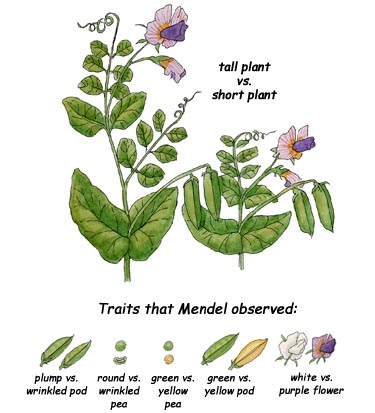
Chromosome: a long strand of tightly coiled DNA wrapped in a protein coat, and found in the nucleus of the cell. Think of it as a suitcase that carries a package of genes. Chromosomes come in pairs; one came from mom and one from dad. Different species have different numbers of chromosomes; fruit flies have 4, humans have 46, corn has several hundred.
Gene: a sequence of DNA that codes for a particular trait. Example: the gene for eye color.
Locus: a physical location on a chromosome where a particular gene is found.
Allele: one of the many possible versions of a gene. Example: the allele for blue eyes or for brown eyes
Genotype: A pair of alleles which code for a particular trait. One allele came from each parent. Genotypes are written as pairs of letters such as Aa or A1A2
Phenotype: The physical characteristic of an individual that is partly the result of geneotype and partly due to environmental influences.
Homozygous: If an individual carries two of the same alleles, it is said to be homozygous for that trait. (Homo=same) Example: AA or aa or A1A1 or A2A2
Heterozygous: If an individual carries two different alleles, it is said to be heterozygous for that trait. (Hetero=different) Example: Aa or A1A2
Dominant: In the heterozygous genotype, the expression of one allele sometimes dominates over the expression of another allele. The dominant allele is by convention written with a capital (upper case) letter.
Recessive: In the heterozygous genotype, the expression of one allele is sometimes masked by another. The allele which is masked is said to be recessive. The recessive allele is by convention written with a lower case letter.
Co-dominant: In the heterozygous genotype, the expression of the two alleles is sometimes blended, resulting in a phenotype intermediate between the two. By convention, co-dominant alleles are written in upper case with subscripts. Example: A1A2
Multi-allelic: The situation where there are more than two possible alleles at a locus. Example: ABO blood type.
Polygenic: The situation where the combined effects of many genes is responsible for the phenotype. In this case, phenotypes exist along a continuum rather than as a few discrete types. Example: height.
Important Note: When Mendel studied his pea plants in that Austrian monastery garden, he was able to work out the inheritance of flower color, plant height, and other traits because he selected ones that were dominant and recessive, and ones where only a single gene determined the phenotype. Whether he got lucky or was selective about which traits to study, we may never know. Much more commonly, phenotypes are the result of co-dominant alleles, where the effects of the pair of alleles is not either/or but rather is blended, and where more than one gene is involved in the expression of the phenotype. Both of these factors would have made it much more difficult to figure out what was going on. This doesn't discredit the mechanisms that underlie Mendelian Genetics, but makes the point that inheritance is usually more complicated.
